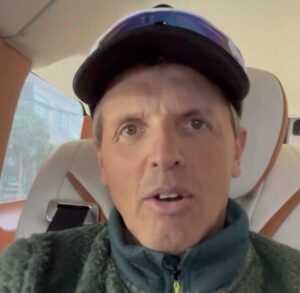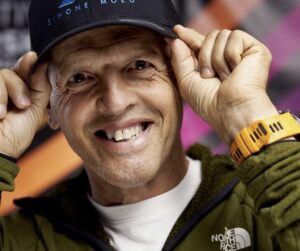In an interview on Bulgarian national television yesterday, Nirmal Purja confirmed that the Nepali team fixed all the upper sections of K2 as they headed for the summit.
“On the previous rotation we fixed from Camp 2, and on the summit day we fixed everything to the summit, and that’s purely because I knew we would be descending in the night,” said Purja. He added that they had previously planned to fix the whole route for safety reasons.

Purja on the summit of K2.
Purja’s comments echo Mingma G’s, who mentioned that descent was rather straightforward, thanks to the fixed ropes.
This contradicts Pakistani climbing legend Nazir Sabir’s recent speculations. Last week, Sabir accused the Nepali climbers of retrieving the ropes as they returned from the summit, implying that this could have affected the safety of John Snorri, Ali Sadpara, and Juan Pablo Mohr, who went missing during their own summit push on February 5.
Purja declined to comment about what happened at Camp 3, when the Seven Summit Treks climbers found so few tents for so many people, saying that he was not there at the time. But he did suggest how to prevent such events from happening in the future: “[Plan] everything meticulously, check everything in advance, and have contingency plans,” he said.
Purja explained that he made the extra effort to climb to Camp 2 ahead of time in order to check the state of the tents and gear after a wind storm and before the summit push. “You need to have a backup plan,” he said. “After so many days in Base Camp, you either need to go and check as I did or carry the gear yourself.”
In the interview, Purja stated that he had meant to climb without supplementary oxygen from “Day 1”, and that he was aware of the magnitude of the challenge: First, because he was not acclimatized enough. Second, on his first rotation to Camp 3, he frostnipped three fingers. Third, because from the outset, he wanted all the Nepalis to reach the summit together while singing their country’s anthem. And finally, because he was concerned that without O2, he would not be able to keep pace with his Sherpa partners, whom he described as always fast but nearly “superhuman” when climbing on O2.
However, everything went according to plan. He used no O2 and noted, “Some of my friends were like Wow, even on oxygen they couldn’t catch up with me.”
Here is the interview (in English):
When did the Nepalis plan their summit push?
In general, Nirmal Purja’s remarks suggest that all the Nepali climbers who headed up to Camps 2 and 3 on January 14 may have planned a joint summit push in advance. Back then, however, Mingma G’s group, the SST Sherpas, and Purja’s own men seemed to be heading up independently to further acclimatize, to rebuild Camp 2 (Purja’s group), and to fix the route to Camp 4 (Mingma G’s group).
Earlier, Purja confirmed that wind had seriously damaged his Camp 2, destroying tents and blowing away gear. “I am just a bit gutted about missing another summit window,” he wrote on January 10, “but the plan is still ON, and the summit plan will be pushed a bit late in the season.”
In fact, Purja didn’t miss that beautiful summit window after all and joined forces with Mingma G and SST’s Sona Sherpa in an all-Nepali summit push.
While this was going on, John Snorri’s team was in Camp 2, about to head to Camp 3. On January 15, Snorri posted: “Today we will take our tent and oxygen to Camp 3. We are making all decisions [based on] our former experience, weather reports, and insights. It is important to keep focus in these difficult circumstances, the unpredictable mountain K2, and the surrounding competitive spirit.”

John Snorri shows destroyed tents behind him at Camp 2 on January 15. Video frame from John Snorri’s Instagram
It was still windy, and Snorri was not sure if the weather would improve. But Mingma G explained later that the Nepalis had their own forecasts confirming the weather window, so they pushed ahead.
Meanwhile, Snorri ultimately decided to take a load of gear to their Camp 3 (lower than the Nepalis’), then retreat for one more night to Camp 2, after which they returned to Base Camp. Ironically, it was they who missed the summit window.
If Snorri and the Sadparas had reached and stayed in the “higher” Camp 3, they would have seen the Nepali team setting off toward the top. Would have they joined them, turning the push into an international one? Would it have been welcomed in the “competitive spirit” to which John Snorri alluded?
Sadly, Snorri will never be able to explain his version of events. Nirmal Purja did not mention the other climbers. But Mingma G did, in an interview with Dream Wanderlust:
On January 14, he said, “a few foreigners [Mingma means non-Nepalis, although his statement also includes Ali and Sajid Sadpara, who were at home there in Pakistan] were resting at Camp 2, right below the Chimney. On January 15, it was a little windy and not at all possible to come from [that] lower camp to Camp 3 directly. In winter, it takes a lot of time to climb up, nothing like in summer. They needed a middle camp between lower camp and Camp 3 since they lost the tent there on January 14. So they could not match our timeline on January 16. This is also why it was only the Nepalese team that went to the summit.”






